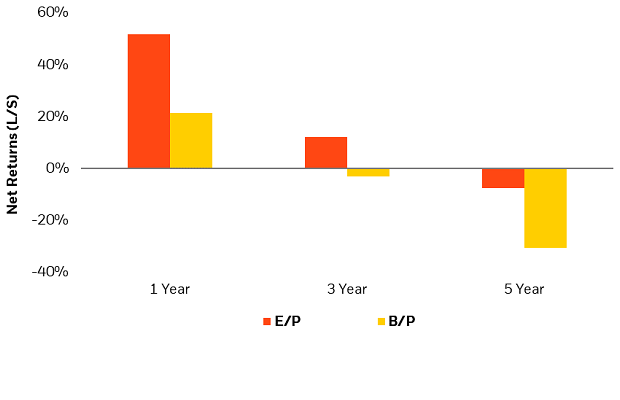Innovations in Factor Investing
Hear my conversation with Armando Senra, Head of Americas ETF and Index Business, on all things factors: What are they, why are we seeing tremendous growth in the space, and how iShares innovation is contributing to this growth.
In its unrivaled 140 years of history in information technology, IBM has continually evolved. The company originally manufactured time clocks for employees to clock in and out, meat slicers, and punch card equipment in the late 1800s. IBM dominated mainframe computers in the 1960s but almost went out of business in the 1990s. It reinvented itself going from hardware to software, artificial intelligence and cloud computing, and other business strategies. That innovation continues apace: IBM was awarded the most patents in 2021, and for the last three decades, has been granted more patents each year than any other US company.1
Like other industries, the investment industry has continued to evolve—incorporating new research and insights. In the 1960s, Sharpe, Lintner, and Mossin built on Markowitz’s earlier work in the 1950s to introduce the Capital Asset Pricing Model (CAPM) showing the importance of the market factor.2 Investors began to recognize multiple drivers of return in theoretical work by Stephen Ross in 1976 and empirical work starting in the 1980s to size, value, and momentum factors.3 4 Richard Sloan introduced the quality factor in 1996,5 and my contributions to the minimum volatility factor came in 2006.6
As our understanding of the underlying drivers of market returns has improved, access to these factors has become mainstream via low cost factor ETFs. Similar to IBM whose focus has continued on excellence in information technology, we remain committed to factors—scientifically researched broad and persistent sources of returns—and innovate in more advanced ways to capture these targeted factors.
Let’s examine new ways to evaluate three well-known factors – value, momentum, and quality – in the next evolution of factor investing and how they can be combined with more traditional insights.
Combining Traditional and Innovative Insights
| Factor | Traditional Insight | Innovative Insight |
|---|---|---|
| Value | Book to price, Cash flow yield, Earnings yield, Dividend yield | Time series cash flow yield |
| Quality | Accruals, Gross profitability, Change in net operating assets | Carbon emissions intensity, Science-based targets Dilution |
| Momentum | Price momentum | Earnings momentum, Earnings announcement drift |
Source: Qontigo. For illustrative purposes only
Redefining Value
Value investing – investing in companies that are priced cheap relative to their fundamentals – is a well-known investing style invented by Graham and Dodd in the 1930s and used by many investment professionals today.7 Traditional metrics like price-to-book and price-to-earnings have been used by practitioners for decades. And while we believe these traditional metrics still apply, there has been a wide dispersion in performance between different value metrics over time.
Value Metric Trailing Returns

Source: Bloomberg as of 3/31/22. E/P is earnings per share divided by share price. B/P is book value per share divided by share price. Value metric returns are for educational purposes only to demonstrate historical context and are not indicative of future results. The returns represent the net long-short return of an equal weighted stock portfolio of the top quintile stock basket minus the bottom quintile stock basket. The performance shown does not represent the performance of an investible product or portfolio and is not reflective of any investment opportunity on BlackRock’s platform. Past performance does not guarantee future results.
Combining traditional insights with newer insights can be used to potentially reduce cyclicality of underlying metrics and more effectively capture measures of value. One example of a newer insight is to look at how expensive companies are relative to their own valuation metrics over time. This is like looking at ourselves in a mirror, noticing how we’ve changed our hairstyle or our wardrobe. In a new signal, “time series normalized cash flow yield,” we look at how a particular company’s cash flows, relative to its stock price, has changed over time. Some companies will always screen expensive when looking solely at their valuation ratios. By looking at the time series, companies undergo cycles of relative cheapness or richness, and if they appear cheap relative to their own history at some point – this presents a potential buying opportunity. Redefining how to find value with a mix of traditional and new insights potentially gives us a more nuanced view of this well-known factor.
Momentum here, momentum there
Momentum investing seeks to capture trends in financial markets. The most common momentum metrics are computed using past prices – like past trailing 12-month or 6-month returns (excluding the most recent month to avoid short-term mean reversion).
But we also observe momentum in fundamental data.
Analyst-based earnings momentum insights, including analyst earnings momentum and earnings announcement drift, could also have independent explanatory power for future returns. In analyst earnings momentum, we look at changes in analyst upgrades/downgrades over the current and following fiscal years. If many analysts are now bullish on a stock, then this could be a good opportunity to buy before these outlooks become capitalized into price trends. When companies beat their earnings expectations, their stock prices have a tendency to continue to drift upwards over time.8 With these two new signals, we may be able to capture momentum trends earlier than waiting for them to be reflected in price movements after 6 to 12 months.
A more expansive view of quality
Quality investing involves buying companies that are profitable, have low amounts of leverage, and have stable and consistent earnings over time. Many investors look for high quality companies by considering ratios like Return on Equity (ROE) and Return on Assets (ROA). But there are other ways to view quality. Advances in ESG data and increasing client demand for sustainable strategies have allowed us to look at ways to look for additive quality characteristics in ESG data.
Our research found two additional quality metrics in ESG data sets: carbon emissions intensity and companies that have made commitments to reduce their carbon emissions through the publication of Science-Based Target Initiative (SBTi) reports. We found companies with lower carbon emission intensity tend to be characterized by higher profitability, higher productivity, and greater operational efficiency – all indications of higher quality.9 Overweighting companies with lower emissions intensity (relative to those with higher emissions), we believe will help performance over time. In addition, we also found positive correlations with companies with SBTi reports and strong financial characteristics like gross profitability.10
These two innovative quality metrics may be considered ESG, but it’s not because companies are suddenly ESG friendly that they outperform. From our research, I believe that companies that are seeking to be most efficient in how they produce services or manufacture goods often search for lower costs of energy and more energy-efficient ways of production. A byproduct of this approach to managing costs is lower carbon emissions. In fact, carbon emission data provides a unique view to operational efficiency because traditional accounting statements do not typically report productivity statistics on how energy is being used in companies’ activities.
Always evolving
Like the best companies that always evolve, factor investing continues to innovate. Information technology changed from capturing data with little holes on pieces of cardboard—punch cards—to recognizing text, faces, and voices. The “how” has changed even though the goal of using information to better run our businesses remains the same. We want to use today’s technology to enrich our lives rather than technology from a century ago.
Ensuring investors are using factor strategies with the newest insights is imperative, especially in a multifactor portfolio where there is a balance between diversifying factor exposure and potentially adding incremental returns. Our US equity factor ETF, LRGF, and International equity factor ETF, INTF, will be changing to new multifactor indexes at the end of May that incorporate these new insights and pair them with traditional insights to provide investors with next evolution in multifactor investing.

